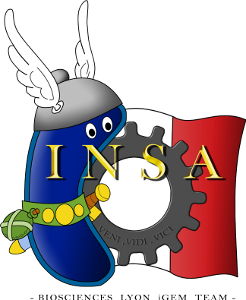Situation
After the destruction of the biofilm by “Biofilm Killer” bacteria, we want to have the choice to either create a surfactant or establish a positive biofilm, both to prevent the recolonization of the surface by deleterious organisms. The toggle switch is done by environmental conditions : two inducers can be added to select one behaviour or another.
Biological system to model
For this, we have created the following construction, with a double regulation:
 Figure 1: The construction of the biological model, with the following elements: 2 promoters (Pxyl and Plac), 2 repressors (LacI and XylR proteins)
Figure 1: The construction of the biological model, with the following elements: 2 promoters (Pxyl and Plac), 2 repressors (LacI and XylR proteins)
and 2 inducers (IPTG and Xylose), and also sfp and abrB genes for Sfp and AbrB proteins.
This system is a gene-regulatory network, where two different states are possible:
- Formation of a naturally toxic bio-surfactant through sfp gene, which has antimicrobial properties that prevents the recolonization of the surface. The surfactant used is surfactin, whose production is activated by the sfp gene. This is the COAT option.
- Establishment of a positive biofilm by the inhibition of the main biofilm repressor gene abrB. This is the STICK option.
 Figure 2: The two possible states, surfactant formation for the top operon or biofilm formation for the bottom construction
Figure 2: The two possible states, surfactant formation for the top operon or biofilm formation for the bottom construction
LacI and XylR proteins are called repressors. They bind to their respective promoters (P
lac and P
xyl), thus preventing RNA polymerase binding. So proteins under the inactivated promoter are not produced.
There are also two inducers in the system,
IPTG (isopropyl β-D-1-thiogalactopyranoside) and
Xylose (monosaccharide of the aldopentose type). In the absence of these inducers, both constructions are inhibited. If only one of them is present, the corresponding inhibition disappears and the associated construction is expressed.
For example, in the presence of Xylose, XylR proteins will form an enzymatic complex with their Xylose sugar. Thus, the inhibition of P
xyl caused by XylR binding will disappear, resulting in an enhanced production of Sfp, AbrB and LacI proteins. Sfp production induces surfactin production, and AbrB production involves the repression of the formation of the biofilm. Eventually, LacI production will inhibit XylR production,
so there will be stabilisation of Pxyl activation.
In opposition, in the presence of IPTG, LacI proteins will bind to their ligand, and P
lac promoter will be free. So XylR proteins will be overproduced, limiting Sfp and AbrB productions. Thus, there will be no surfactin in the environment, biofilm formation can begin.
Aim of the model:
With this model, we pursue two main objectives :
- 1) verify the design of the biological system, to be sure that the toggle switch is functional,
- 2) predict the behaviour of this biological system depending on the presence of inducers to give usage guidelines for its industrialization
However...
We are working in a
Bacillus subtilis strain and some parameters such as XylR values on binding/unbinding kinetics to both inducer and promoter or production rate from P
xyl promoter cannot be found in the literature and most of the existing values come from an
E. coli strain rather than
B. subtilis.
Furthermore, we are finishing the biological system construction and its characterization is underway. Parameters will be measured very soon.
Because of this lack of information, we will create a theoretical model in order to characterize the global behavior of the system.
Moreover, as we are mainly biologists in the team, we thought interesting to explain how we can easily obtain a mathematical model from a biological system.



 "
"
















